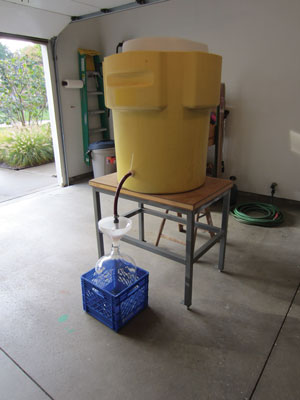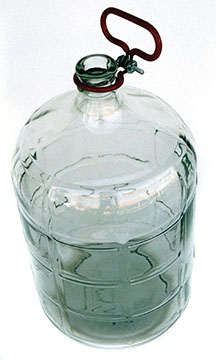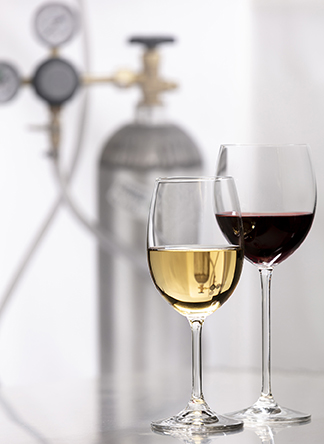
In earning a chemistry degree and working in laboratories, I thought of “inert gases” as being the same as the “noble gases” of the periodic table: Helium, neon, argon, krypton, xenon, and radon. Once I started making wine, though, and got into some more advanced topics, I found winemakers consider the inert gases to include argon, nitrogen, and carbon dioxide (carbon dioxide is not really inert — more on that later.) One more gas — a blend of two of these— comes up in winemaking as well. That is “beer gas,” a blend of nitrogen and carbon dioxide. As the name suggests, it is most commonly used by brewers (usually for dispensing beers “on nitro”) but it finds use in wineries as well. The gases used in winemaking serve mostly to prevent or minimize oxidation of wine. Even though not fully inert, I’ll call them that in this article since that is common usage in winemaking.
For some winemaking applications, one or another of these inert gases may be clearly superior. For others, you may be able to make substitutions. After we consider the characteristics of the four gases, we will review their principal uses. In roughly the order they might come up during a winemaking cycle, we will look at cold soaking, extended maceration, container purging, wine transfer, sparging, bottling, carbonating, and dispensing.
Get to Know Your Gases
Argon
Argon (Ar) is the lone noble gas of the periodic table used in winemaking. It is resistant to all chemical reactions and is denser than atmospheric air, giving it an advantage in filling vessels or displacing a layer of air. It has a density of about 1.78 g/L, compared with air at about 1.29 g/L. (The density difference is also why noble gas helium is of no interest to winemakers. At less than 0.2 g/L, it would dissipate immediately.) Argon is a pure element in monatomic form: Individual Ar atoms make up the gas.
To use argon in your winery, you will need a compressed gas cylinder, a pressure regulator, and various hoses and fittings. A common size for home use is a 19-cubic foot (538-L) cylinder, named for the volume of gas upon release at atmospheric pressure. The cylinder is about 14 inches (36 cm) tall and 5.25 inches (13.3 cm) diameter. The gas is compressed to about 2,000 psi (pounds per square inch) or 13.8 megapascal. Argon, nitrogen, and beer gas use an inert gas regulator with a connection designated CGA #580 by the Compressed Gas Association. Such a regulator can be used interchangeably on those three gases. Fermentation supply stores and welding gas outlets sell tanks and fittings. Argon costs about $250 for a full 19-cu. ft. cylinder and a regulator is about $90. The cylinder can be refilled or exchanged at a lower cost.
Nitrogen
Nitrogen (N2), the diatomic gaseous form of nitrogen, is what we are considering here. As a winemaking gas, it is unreactive and works well in many “inert” applications. As an element, home winemakers know nitrogen as a component in compounds like DAP (diammonium phosphate) and amino acids that do react with other wine components. For inert gas use, molecular nitrogen can be used at a lower cost for most of the same purposes as argon. The gas in contact with juice or wine does not spontaneously react with any other constituents. One drawback for nitrogen in blanketing or inerting operations is a density slightly lower than air: 1.25 g/L for nitrogen vs. the 1.29 g/L for air. It mixes easily with air and dissipates quickly.
Distributed in the same cylinders as argon, it uses the same regulator. It has a lower cost than argon with a 19-cu. ft. (538-L) cylinder selling for about $235, but may add more cost per use because its density makes it a less effective blanket gas. Cylinder refills or exchanges are less expensive as well.
Carbon Dioxide
While it is used for many of the same oxygen displacement purposes as argon and nitrogen, carbon dioxide (CO2) is not inert. In contact with water or wine, some molecules combine with water according to the reaction:
CO2 + H2O ⎝ H2CO3
From there, a fraction of the resulting compound dissociates like this:
H2CO3 ⎝ HCO3– + H+
Seeing that H+ lets us know that hydrogen ions are present: An acid-forming reaction. In solution, carbon dioxide is sometimes called carbonic acid. Unreacted molecular carbon dioxide remains dissolved as well. Rising temperature or agitation causes gas to leave solution. Wines with noticeable carbon dioxide are considered spritzy, petillant, or sparkling. If you do not want spritzy wine, you must be careful in your use of carbon dioxide as your “inert gas.” It has one clear advantage in its density of 1.98 g/L, making it the heaviest of the winemaking gases. CO2 condenses to a liquid when pressurized in a cylinder. As a result, cylinders are sold by weight rather than nominal volume. Most common for home use is a 5-lb. (2.3-kg) cylinder that is about the same size as the 19-cu. ft. cylinders argon and nitrogen come in. A full 5-lb. (2.3-kg) cylinder costs about $125 and will release about 44 cu. ft. (1,250 L) at atmospheric pressure. A refill or exchange costs about $40. Because the contents are in liquid form, a CO2 cylinder must be kept upright in use, presenting only headspace gas to the regulator. If liquid CO2 were to enter the regulator, its sudden evaporation would damage the equipment. CO2 requires a specific CO2 regulator that cannot be used with the other gases mentioned.
Beer Gas
Used primarily for dispensing draft beer, this blend of nitrogen and carbon dioxide is most commonly found in a ratio of 75% nitrogen and 25% CO2. With that blend, beers like Guinness Stout and Boddington’s Pub Ale on draft maintain the cascading bubbles and creamy mouthfeel that drinkers expect from “nitro” beers. For winemaking, beer gas is used for the same purposes as the other inert gases. In contact with wine, some carbon dioxide will dissolve, but not usually enough to carbonate the wine or make it “sparkling.” Blends with a higher carbon dioxide ratio are available, but offer no particular advantage to the home winemaker. Because nitrogen does not condense to a liquid under pressure, the tank and regulator for beer gas are the same high-pressure equipment as for nitrogen or argon. A full 19-cu. ft. (538-L) cylinder costs about $230, offering a small price advantage over argon or nitrogen.
What Else You’ll Need
Once you have purchased a full cylinder and appropriate regulator of your chosen gas, you will need some other hardware. Most regulators have an on-off valve already fitted. Have one installed if yours does not. You will also need to buy some beverage-grade tubing that fits your regulator. Between five and 10 feet (1.5 to 3 m) works well for most, but take into account your winery layout. If you intend to use your gas for sparging wine (more on this later), efficiency will be improved if you buy a fritted stainless steel sparging stone. A hose-end spring loaded squeeze valve may be convenient. You may add other fixtures like quick disconnects, inline valves, or a flow meter.
The cylinders described here are small and portable, but keep them secure to prevent falling over, breaking off a valve, and causing a dangerous sudden release of pressure. Before addressing specific applications, a note of caution. Just as these gases displace oxygen in fermentation vessels, they displace air in a room. Use only in very well-ventilated spaces or outdoors to avoid risk
of asphyxiation.
Gas Uses in Winemaking
Cold Soaking and Extended Maceration
These two techniques use inert gas in the same way. For cold soaking, grapes are crushed into a fermenter and held at a low temperature prior to warming up and initiating fermentation. An extended maceration is done when the wine is finished fermentation, still on the skins and seeds, and allowing it to rest a while before pressing. In both, your juice or wine is at risk for oxidation, browning, and development of aldehydes. To minimize those risks, you can blanket the headspace with an inert gas.
Carbon dioxide is heavier than air and cheaper than the other winemaking gases, so it is a good choice for this application. All three of the other gases discussed here will work well, too, but the light weight of nitrogen may cause it to dissipate more rapidly. Blended beer gas is likely to stay in the fermenter a bit better and poses no risk of over carbonating, as the wine is still in the very early stages of production.
To cold soak, put a tank lid or heavy plastic sheet over the fermenter with the fruit or must in it. Run a hose from your gas regulator under or through the cover, set your regulator to 5 to 10 psi (35 to 70 kpa), and make sure there is an opening in the cover to let displaced air and excess gas out. Open the valve for a minute or two. If you have a flow meter fitted, calculate the volume of headspace in your fermenter and run twice that volume for the purge. Three to four volumes is preferred in commercial inerting, but twice should give you reasonable protection for 24 hours. Renew the inert gas layer daily.
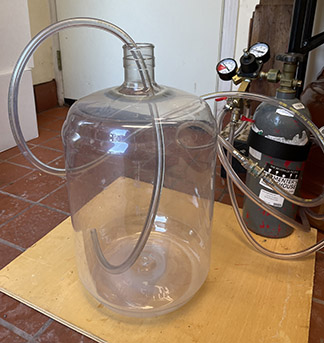
Purging and Flushing
Container purging or flushing is similar to must blanketing. The goal is to use your inert gas to displace the atmospheric air in a carboy, tank, or barrel so oxygen contact is minimized when wine is transferred into it. Early in the fermentation cycle, carbon dioxide is a good choice due to its density and cost. Excess CO2 is not a problem as the wine is already high in dissolved carbon dioxide at an early stage. In this operation, place the end of the hose near the bottom of the vessel and open the valve. Flush a 5- or 6-gallon (19- to 23-L) carboy for 30 seconds or so. With a flow meter, three to four volumes of gas is ideal to reduce the residual oxygen level to less than 1%. For a larger vessel, like a 200-L (52-gallon) variable capacity tank, the gas used in three volume changes is substantial. At 3 x 200 L, or 600 L total, you would need more than the entire volume of a 19-cu. ft. (538-L) argon, nitrogen, or beer gas cylinder. With the larger volume of a 5-lb. (44- cu. ft., 1250 L) CO2 tank, you would use about half of a full cylinder. As with blanketing, make sure there is an adequate opening for displaced air and excess gas to escape while purging.
Transferring Wine
The use of inert gas in wine transfer is an extension of purging. Purge the receiving vessel, initiate your siphon or pump, and slowly bleed inert gas into the headspace of the source vessel to prevent air from entering as the wine is drawn out. You can check this by holding a lit match above the opening of the vessel being emptied and make sure the flame is extinguished by an excess of gas flowing out. That will assure that air is not getting in.
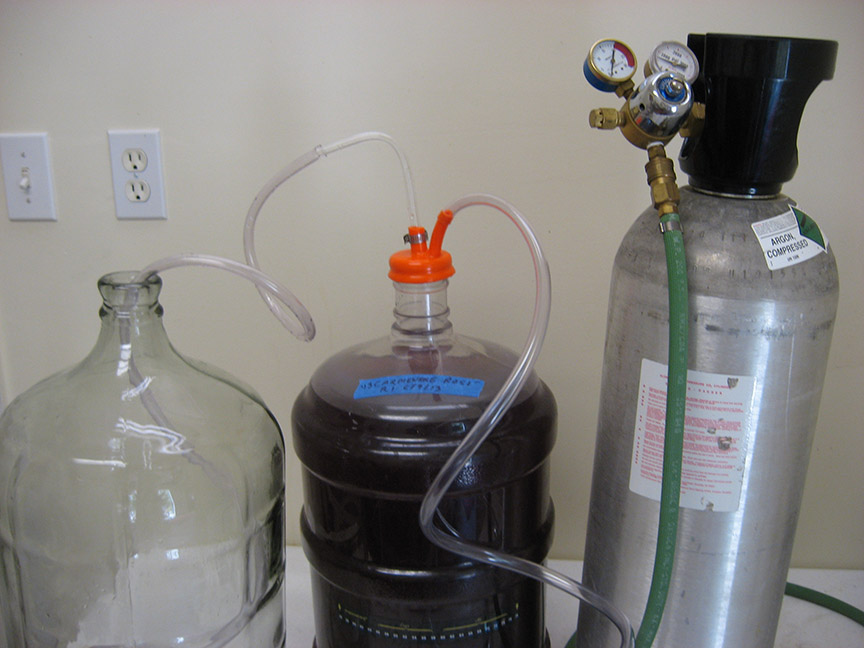
Another transfer technique is to pressurize the full container. Do not pressurize glass carboys. Polyethylene terephthalate (PET) plastic carboys can be pressurized enough to move wine. A transfer system for such carboys can be easily assembled from supplies found at most home winemaking shops. First, cut off the tip of the center connection on an orange two-port carboy cap. Then thread a 24-inch (60-cm) long by 3⁄8-inch (1-cm) diameter racking cane through that opening, arranging it to nearly touch the bottom of the carboy when the cap is snapped on. Attach a length of 3⁄8-inch (1-cm) ID vinyl tubing to the racking cane and drop the end to the bottom of your receiving carboy. Purge the receiving carboy and leave it open. Attach a 3⁄8-inch (1-cm) line from your regulator to the second port on the orange cap. With everything arranged, start with your regulator knob backed all the way out so no pressure is being delivered. Be careful not to over pressurize the carboy! Open the main cylinder valve, then slowly turn the regulator knob in, raising the pressure until the wine begins to flow. Do not exceed 5 psi. When all the wine has been moved and gas enters the racking cane, turn the flow off and disconnect. (This same system can be used to purge a PET carboy using less inert gas than ordinary flushing. Fill the carboy with clean water or no-rinse sanitizer solution, attach the cap and racking cane, and use your gas to push the water out. The carboy is now completely filled with inert gas using only one volume. If you are processing more than one carboy, you can transfer the water or sanitizer to the next one in line, reusing it instead of pouring it down the drain.
Sparging
To remove unwanted dissolved gases from your wine you may sparge with inert gas. Common nuisance gases targeted for removal are excess carbon dioxide, oxygen, and hydrogen sulfide. The technique involves placing your gas hose outlet near the bottom of the container, opening the top, and running gas bubbles through the wine. As the bubbles rise in the liquid, some of the target gas will transfer to the bubbles and exit. Finer bubbles allow better gas-to-liquid contact, so a fritted sparging stone, available at home winemaking suppliers, will make the operation more efficient.
If your wine is ready for bottling but seems too “spritzy” due to dissolved carbon dioxide, purge for a few minutes with argon or nitrogen. Since some wines are more pleasant with a small amount of dissolved carbon dioxide, using beer gas may avoid making the wine too “flat.” If you are concerned about oxidation in your wine after racking, any of the inert gases may be sparged through it to remove excess oxygen.
Finally, if you detect the “rotten egg” smell of hydrogen sulfide, you may be able to sparge it out in the same manner. As always, work in a well-ventilated space as hydrogen sulfide is toxic and the inert gases are asphyxiants.
Bottling
Some of the previously discussed operations may be combined to assist in bottling your wine with less risk of oxidation. Attach a plastic single-bottle type filler to a hose from your regulator. Gently open the regulator to a very low pressure like one or two psi (7-14 kpa). As you are ready to fill each bottle with wine, push the bottle filler against the bottom for a few seconds to purge the bottle. As the bottles are being filled, slowly add inert gas to the headspace of the bulk container to minimize oxygen transfer on that end. If you use a 3-spout or 5-spout bottle filler, you can install a fitting with a hose barb in the lid to allow continuous flushing while bottling. For this use, argon and nitrogen are preferred as adding CO2 at bottling may change the wine. Just before corking, you can shoot a puff of inert gas into the bottle’s headspace.
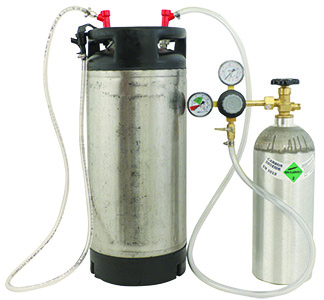
Kegged wine can be served sparkling with carbon dioxide or still if using argon or nitrogen.
Serving on Draft
If you serve your wine on draft instead of bottling, you have one more use for inert gas. If you use carbon dioxide, your wine will become carbonated and you will have sparkling wine on tap. This can be a fun and easy way to create a sparkling wine; but you can also dispense still wine on tap by using argon or nitrogen. For either system, you will be dipping into the brewers’ side of your local fermentation store. Originally manufactured as soda syrup tanks before the advent of bag-box packaging, 5-gallon (19-L) stainless steel kegs are still produced and may be used for draft beer or wine. Most common are so-called “ball-lock” kegs, named for the quick disconnect fittings on the top. The “in” fitting is connected to your gas regulator and the “out” fitting is connected to a beverage faucet or a so-called “cobra tap” that does not require a faucet (as pictured above). For sparkling wine you need to keep the keg in a refrigerator, typically at about 36 °F (2 °C) and 11 psi (76 kpa), to assure adequate dissolved gas for a pleasant sparkling wine. For still wine, argon and nitrogen do not significantly dissolve in the wine, so you can chill if you want for white or rosé wine or just leave the keg at room or cellar temperature for red wines. With any of the inert gases pushing the wine, you do not need to be concerned about oxidation as the gas pressure in the keg keeps air out.
The same technique as described earlier for purging a PET carboy can also be used for a keg to minimize air exposure during transfer. Fill the keg with clean water or sanitizer, snap an “out” fitting on the appropriate port with a hose to drain, attach your gas, and flush. If your wine is in a PET carboy, you can then push it into the keg in the same manner.
Some home winemakers are trying to reduce their use of sulfites in winemaking. While sulfite is the cheapest and easiest fighter against premature oxidation, now you have been introduced to four more: Argon, nitrogen, carbon dioxide, and beer gas. Carefully applied, they may allow you to use less sulfite and still make delicious, fresh wine without excess oxidation.



